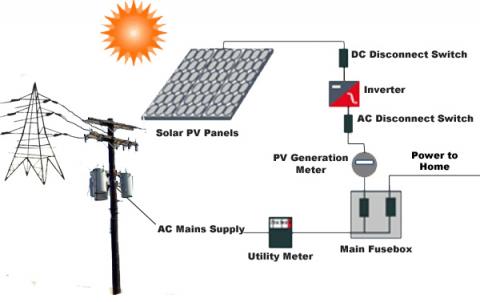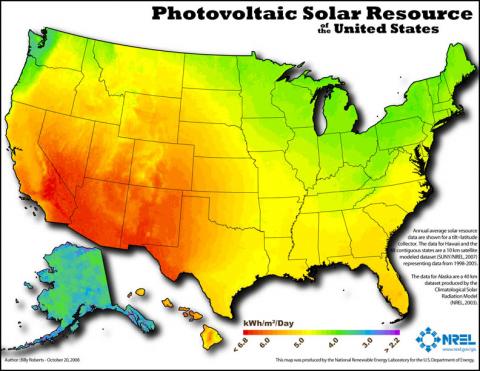If you're interested in installing a solar PV system, this is the best place to start.
Solar Photovoltaic (PV) panels use photons from the sun to create electricity. For an in-depth knowledge of how a PV panel works, HowStuffWorks has a decent article on the topic and NASA provides a nice explanation on how PV works. For the remainder of this article, we're going to assume you believe us when we say that solar PV panels do work, so we'll help you learn how to incorporate them onto your home.
Solar PV system
There are a three main solar PV system configurations:
- Grid-tie
- Grid-tie with battery storage
- Off-Grid battery storage
If you have access to the electrical grid (electrical wires come into your house from an electrical utility), then chances are you want to use a grid-tie system. You only need grid-tie with battery storage or off-grid if you want to have a backup in case the electric grid goes down (grid-tie with battery storage) or if you want don't want to be dependent on the electric utility (off-grid battery storage).
In short, a grid-tie system sends any energy produced by your solar panels (and not used by your home) back onto the electrical grid, and your utility will usually credit your account for the energy produced. We will discuss more on the different PV system configurations on another article. An example of a grid-tie schematic can be seen below:

The majority of homeowners will install solar PV panels on their roof, but if your roof wont work and you have the space on the ground, you can also install a ground or pole mount system.
Before we get too caught up in the technology, let's look at the steps you need to take to determine if solar PV makes sense on your home. This is meant to be a primer to give you the knowledge you need to talk to a professional solar PV installer. We don't recommend installing solar panels yourself, as it can be dangerous and deadly if not done correctly.
Geographic Region
As you can see from the map provided by NREL below, the solar resource is not the same everywhere in the U.S (red is better, green is worse). Where you live plays a big part into how much electricity your solar panels will produce. Of course, the biggest hurdle to installing solar PV is the up-front cost of a system and the return of that investment. Often times the ROI of a solar PV system is dependent more on the incentives and financing available for installing a clean energy generating system than how much energy that system generates. For much of the early 2000's, New Jersey had some of the best incentives in the country, which made installing a PV system in New Jersey as good if not a better investment than one in Arizona, the state with the most red below! This brings us to our next topic, Incentives.
Incentives
The incentives available in your region to install solar PV panels will have the greatest impact on your return on investment. These can be tax incentives by your state and/or the federal government, incentives from your utility, feed-in-tariffs, or rebates. The website SolarPowerRocks has a nice state by state breakdown of solar incentives by state, a history of how each state is performing and a breakdown of the solar PV payback per state. Please keep in mind that some of this data may not always be up to date, but it's a great starting point.
One you check out your state on SolarPowerRocks, head over to DSIRE.gov's solar section. DSIRE is the database for state incentives for renewables and efficiency, and is the most trusted and up-to-date listing of incentives on the internet.
DSIRE also has data on Federal solar incentives that everyone living in America can take advantage of. Once you are familiar with solar incentives, you can figure out how they will impact the financial performance of your system, which is related to our next topic.
Financing
As you may have heard by now, solar PV can be expensive, but so is the house you are putting them on. A PV system is an investment that lowers your utility bills and your impact on the environment, but it can take a chunk out of your wallet. Luckily, if you don't have the money put away in savings to pay for a PV system, you have other options.
Financing solar power systems has gained popularity over the past few years. Keep in mind that many of the incentives listed above play a large role in many of the financing options that may be available.
One Block Off the Grid (related to SolarPowerRocks mentioned above) maintains an excellent page on solar financing. Their categories include (with their corresponding hyperlinks):
1. Solar Power Purchase Agreements (PPAs)
2. Solar Lease – also see the great post that CleanTechnica just put up on leasing solar.
3. Home Equity Loans – also see Energy Efficient Mortgage
4. SRECs: Solar Renewable Energy Credits
5. PACE Muncipal Financing (Property Assessed Clean Energy)
6. Peer to Peer Lending (P2P)
7. Feed-In Tariffs (FIT)
Calculating Annual Solar Power Output
Now that you have a little background on the PV solar system and different incentives and financing options, you're ready to run some numbers and look at how much energy your solar PV system will produce over the course of a year. NREL has created one of the most popular tools for this calculation, titled PVWatts. To use this tool, you need to know three main things:
- Where the sytem is being installed
- What you pay per kWh (from your utility bill. Take total amount of bill and divide by total kWh. This is the $/kWh and includes taxes and fees that are based on how many kWh you use)
- What size of a system you will be installing
The first two items should be pretty self explanatory. The third item is determined by what your physical limitations of your roof, your budget, and what your solar goals are.
Many people think that to install solar, they need to install a PV system that will provide all of their electrical energy needs, but that is only if you are going off-grid with battery storage. If you are using a grid-tie system, you can install a system of any size; however, be aware that if you install a system that produces more than you use in a year, your utility may not reimburse you for any energy you put back on the grid that is over the amount you consume in a year. For the majority of homeowners, it is cost prohibitive to install a system that produces more than what they use in a year. The decison then becomes finding a system size that meets your goals and budget.
Pricing PV system installations
Once you have an idea of the solar PV basics, the type and size of system you want, and financing and incentive options, you're ready to speak with a solar installer. Solar installers will come out and take a look at your roof or property, understand your requirements and goals, and work with you to provide a quote.
When looking for an installer, you want one that will provide a turn-key project quote, meaning they will handle everything including:
- Product
- Installation
- Certification
- Help in gaining all incentives and rebates if available
- Help understanding all financing options that may be available to you
If an installer doesn't demonstrate a proficiency in any of the above, you should question their capabilities. Like most home energy projects, it is helpful to get at least 3 bids to ensure you have a good comparison.
Conclusion
Many homeowners are surprised to learn that a solar PV system is more an exercise in economic analysis than energy analysis. The energy side of things will be determined by your constraints and the type of system you need. The more challenging side of things will be how the system is paid for!
If you can get over the technical and financial hurdles, take pride in knowing you are that much more self-sufficient and are helping our environment by using the free energy from the sun!
Other Links:
http://www.gosolarcalifornia.ca.gov/solar_basics/how.php
http://www.aprs.org/off-grid-maybe.html


Post new comment